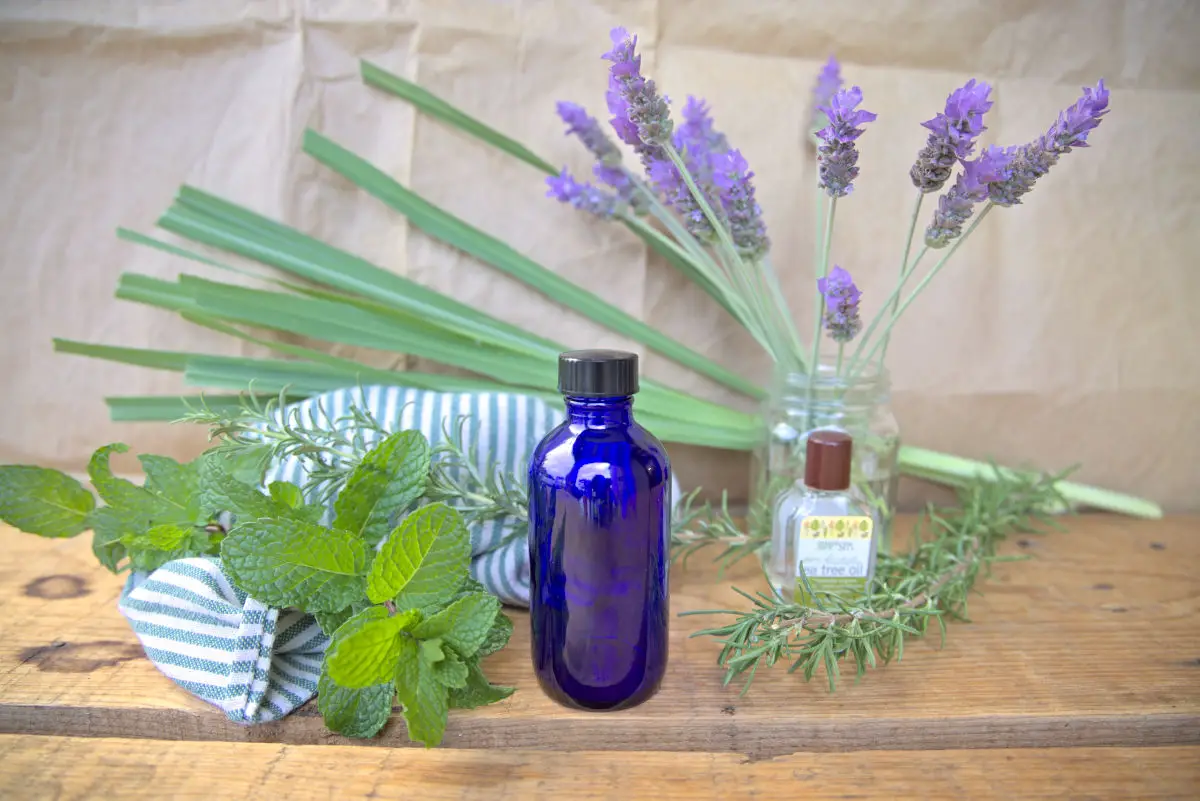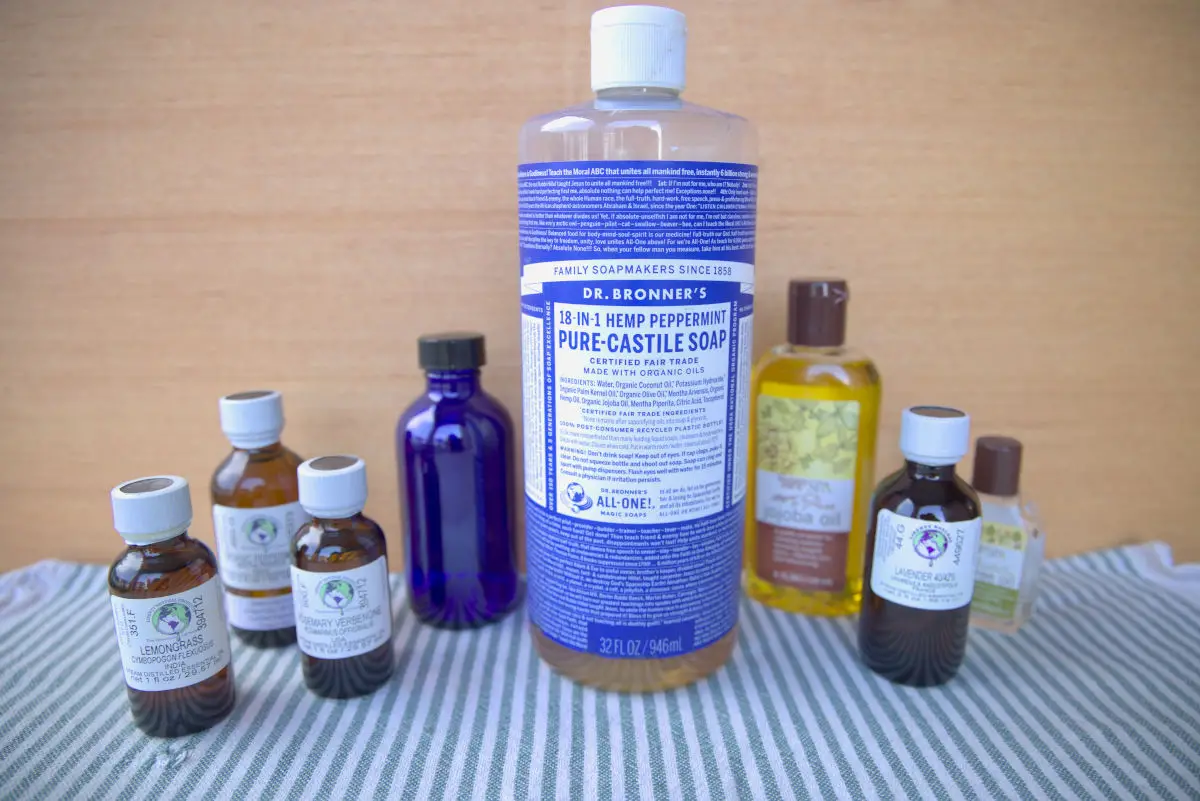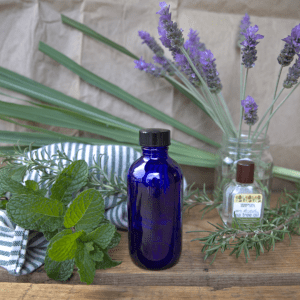Looking to go more natural? There’s a shampoo for that! We’ll teach you how to make shampoo at home with just a few easy-to-find ingredients. Many commercially made beauty products strip your hair of its natural oils, but using a natural, clean shampoo works to keep them in balance.

Fair warning: transitioning to natural shampoo can be a journey for some. If your hair is used to store-bought shampoos- whether filled with toxic chemicals or considered organic- it will take some time to adjust. You’ll find that after the adjustment period, you will have to wash your hair less frequently! 2-4 times a week is a standard frequency.
The Basics: Essentials
Distilled Water- Using distilled water (instead of regular tap water) is important for homemade beauty products because bacteria and fungi thrive in moist conditions. Starting with distilled water ensures that it is free of microbes at the start.
An excellent alternative to distilled water is hydrosols. Whether you choose rose, lavender, orange blossom, peppermint, tea tree, or another, they can help lengthen the shelf life of your shampoo. You can replace the entire portion or a smaller portion of distilled water with a hydrosol.
If you become concerned with the health of your shampoo, there are natural preservatives you can choose to add.
Castille Soap- The most readily available is Dr. Bronner’s, but any pure Castille soap will do. You can choose from unscented or naturally scented varieties. It’s important to be aware of the fact that the pH of Castille soap is around 8 while your hair’s natural pH level rests at around 5. It might not be an ideal ingredient for someone with treated hair. I recommend following up this shampoo with an apple cider vinegar rinse to help balance out the pH.
Oil- My favorite oil to use is jojoba, but you can experiment with oils such as argan, castor, avocado, or coconut. The varying consistency of coconut oil in different temperatures can make it tricky to work with, and for some hair types it might actually dry out the hair.

Optional Ingredients:
Some faults people have found with this basic recipe include that it is too thin, doesn’t have a long shelf life, or doesn’t emulsify well. Here are some options for solving these issues.
Use a natural emulsifier. Oil and water don’t naturally mix, so to avoid vigorous shaking before every use of your shampoo, use an emulsifier that will help blend and stabilize the molecules. Emulsifying waxes such as this one are excellent for this. Make sure you are choosing an option that is naturally derived and following the directions for what percentage to use in the recipe.
Use additional natural preservatives. This is an excellent article on natural preservatives that would be options for your shampoo. Antioxidants like Vitamin E oil and Rosemary oil aren’t considered true preservatives by purists, but they will help extend the shelf life.
Use a natural thickening agent. Using an emulsifying wax will help thicken your shampoo, but you can also try using a thickening agent such as cornstarch. A little goes a long way here.
Essential Oils- While technically optional, the addition of essential oils will not only create a lovely fragrance element to your shampoo but also benefit the health of your hair and scalp.
Essential Oils
If you’re new to using essential oils, welcome. It’s an expansive world with countless uses and benefits. Adding these natural extracts into your haircare routine will boost your overall hair health. Gently massaging the shampoo into your scalp and allowing it to sit for at least a minute will ensure that the essential oils can work their magic.
Do your own research before using essential oils on small children.
Essential oils all have their own attributes. Based on your natural hair type, consider using these:
Normal hair: Lavender, Rosemary, Geranium, Lemon, Clary Sage, Cedarwood, Thyme, Chamomile, Tea Tree
Oily hair: Lemongrass, Lemon, Tea Tree, Ylang-ylang, Cypress, Cedarwood, Rosemary
Dry hair: Geranium, Tea Tree, Sweet Orange, Lavender, Rosemary, Cedarwood, Peppermint, Sandalwood
My favorite essential oils for shampoo include:
Lavender- Often known for its antimicrobial & anti-inflammatory properties, lavender also acts as an excellent soothing agent for the scalp. It promotes hair growth and works to reduce hair loss. [1]
Tea Tree- Historically used for its anti-septic & anti-inflammatory characteristics, tea tree oil has shown promise in strengthening hair follicles. It contains antifungal properties that help combat dry scalp conditions. [2]
Rosemary- Prized as a natural antioxidant, rosemary aids in the general health of hair and promotes hair growth. [3]
Lemongrass- Rich in antioxidant, skincare, and antimicrobial compounds, lemongrass helps with oil control while exhibiting a bright, citrusy fragrance. [4]
Peppermint- Besides its naturally calming effect, peppermint has been shown to promote hair growth through increasing dermal thickness, hair follicle number, and hair follicle depth. [5]
Chamomile- A gentle oil, chamomile is great for those with sensitive scalps. It is effective at helping to treat dry and itchy skin while enhancing the health of your hair. [6]

Alternative Natural Shampoo
Different hair types react differently to different ingredients. You might find that a particular oil doesn’t suit your hair or that Castille soap isn’t leaving your hair the consistency you desire. Don’t be afraid to experiment to find the natural shampoo that works for you.
There’s another great recipe for a more pH-balanced shampoo that calls for 1 can of full fat coconut milk, 2 TBSP raw liquid honey, 2 tsp jojoba oil, 2 TBSP apple cider vinegar, and drops of essential oil. The major drawback of this one is that you have to store it in the fridge and either make it frequently or freeze it in portions in ice cube trays to be thawed out in the fridge.
Using and Storing Shampoo
If you haven’t added a thickening agent, your homemade shampoo will be much thinner than the shampoo you’re used to buying. But, don’t let that scare you away. Your homemade shampoo also won’t lather like the commercially produced ones. But, it will do the job regardless.
If you haven’t added an emulsifying agent, be sure to shake your shampoo before each use. You can pour a small bit on your hands and rub them together before massaging it into your hair.
Store your shampoo in a glass container. Make sure it is clean before adding your shampoo because cleanliness is the key to extending your shampoo’s shelf life. Using a darker glass and storing it in a darker location will help protect it from oxidation. The safest storage location is in the refrigerator, but we have no problems storing a small batch of ours in the bathroom.
Remember that we’re trying to avoid excess moisture and any other harborers of bacteria from entering our shampoo. Try to refrain from touching the inside of the bottle or its contents with unsanitized hands.

Natural Shampoo Recipe
Ingredients
- ¼ c distilled water
- ¼ c castille soap
- ½ tsp jojoba oil (other options include castor, avocado, or argan)
- 12 drops essential oils* optional
- emulsifying wax optional, see post
- natural preservative optional, see post
- cornstarch optional, see post
Instructions
- Add ingredients to a glass bowl and mix thoroughly.
- Use a funnel to transfer your shampoo to a small glass jar.
Notes
- *My favorite essential oil combinations are tea tree/peppermint, lavender/rosemary, and rosemary/lemongrass. See the blog post for other options and specificities.
- The blog post contains information on adding an emulsifier or natural preservative to your shampoo.
- See the blog post for details on using & storing your homemade shampoo.
Sources:
[1] Lee, B. H., Lee, J. S., & Kim, Y. C. (2016). Hair Growth-Promoting Effects of Lavender Oil in C57BL/6 Mice. Toxicological Research, 32(2), 103-108. https://doi.org/10.5487/TR.2016.32.2.103
[2] Sakr, F. M., Gado, A. M., Mohammed, H. R., & Ismail Adam, A. N. (2013). Preparation and evaluation of a multimodal minoxidil microemulsion versus minoxidil alone in the treatment of androgenic alopecia of mixed etiology: A pilot study. Drug Design, Development and Therapy, 7, 413-423. https://doi.org/10.2147/DDDT.S43481
[3] Begum, A., S, S., N, A. K., & Ali, S. S. (2023). Evaluation of Herbal Hair Lotion loaded with Rosemary for Possible Hair Growth in C57BL/6 Mice. Advanced Biomedical Research, 12. https://doi.org/10.4103/abr.abr_306_21
[4] Kim, C., Park, J., Lee, H., Hwang, Y., Park, S. H., & Lee, H. (2022). Evaluation of the EtOAc Extract of Lemongrass (Cymbopogon citratus) as a Potential Skincare Cosmetic Material for Acne Vulgaris. Journal of Microbiology and Biotechnology, 32(5), 594-601. https://doi.org/10.4014/jmb.2201.01037
[5] Oh, J. Y., Park, M. A., & Kim, Y. C. (2014). Peppermint Oil Promotes Hair Growth without Toxic Signs. Toxicological Research, 30(4), 297-304. https://doi.org/10.5487/TR.2014.30.4.297
[6] Lee, H., Heo, Y., & Kim, C. (2010). Effect of German chamomile oil application on alleviating atopic dermatitis-like immune alterations in mice. Journal of Veterinary Science, 11(1), 35-41. https://doi.org/10.4142/jvs.2010.11.1.35


How much corn starch and/or vitamin E oil do you add to the recipe?
I would add Vitamin E at .5% of the weight of your shampoo. A little goes a long way! It should be about 1/4 tsp when using 1/4 c castille soap and 1/4 c distilled water. I haven’t personally thickened my shampoo with cornstarch, but I know people who have. I would say start with 1/2 tsp for this recipe. If cornstarch clumps for you, try xanthan gum or arrowroot powder!